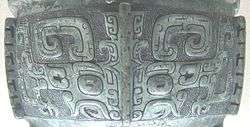饕餮
Chinese
| gluttonous | gluttonous | ||
|---|---|---|---|
| simp. and trad. (饕餮) |
饕 | 餮 | |

饕餮 (taotie motif)
Pronunciation
Noun
饕餮
Derived terms
|
|
This article is issued from
Wiktionary.
The text is licensed under Creative
Commons - Attribution - Sharealike.
Additional terms may apply for the media files.